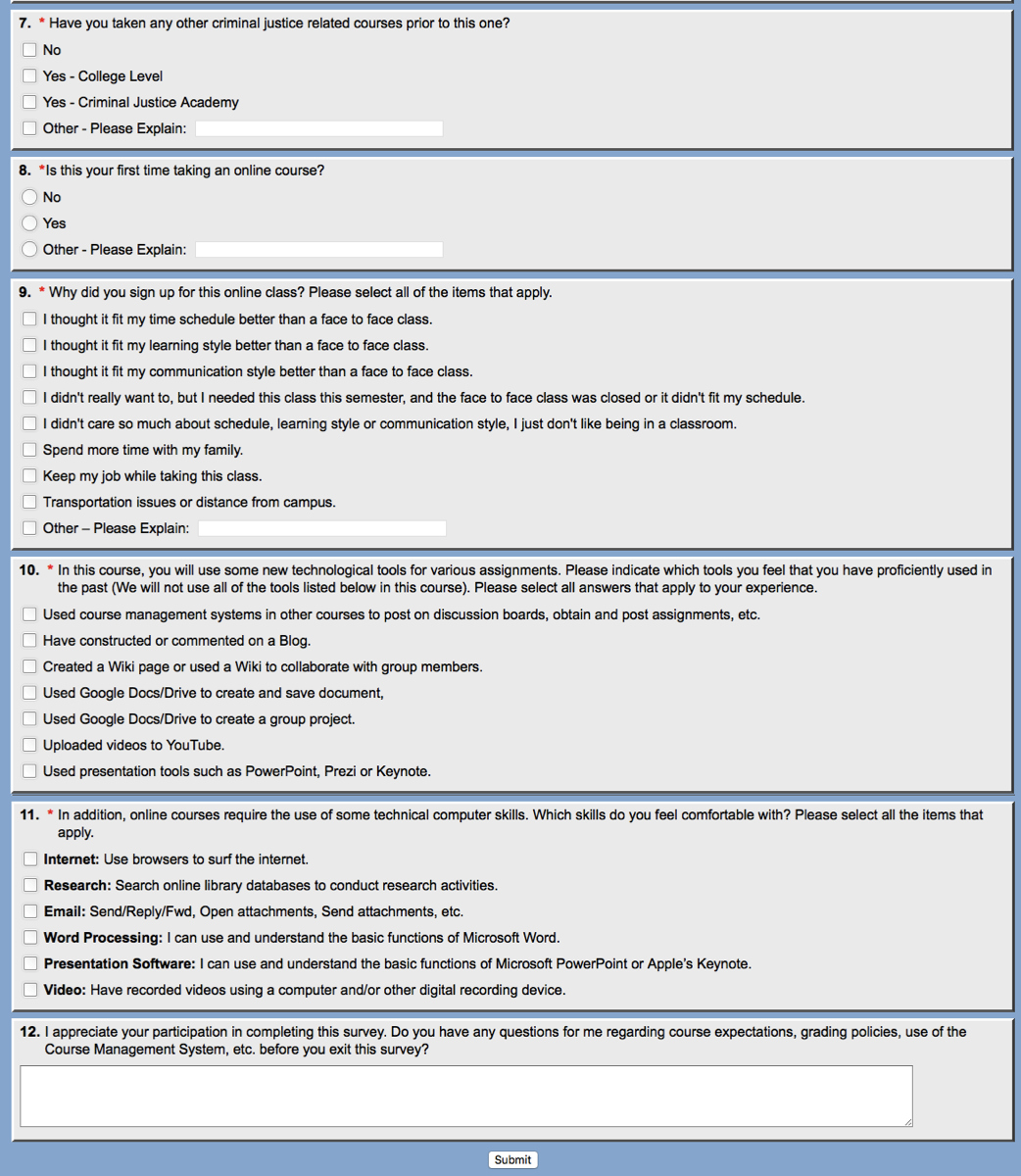STAY in TOUCH
Establishing a Learning Environment
The absence of face-to-face interaction in a synchronous or asynchronous online learning environment presents numerous challenges with the design, development, and implementation of course content. Accordingly, it is imperative that educators understand and appreciate the importance of providing an online learning experience that focuses on student learning processes rather than the instructional methods used in the traditional classroom setting. An crucial first step in this endeavor is to conduct an analysis of the student populations and determine the best methods for supporting learners with varying levels of knowledge and skills. The artifacts shown below were developed to provide the online course facilitator with information concerning the student population, authenticity and diversity of learning activities, and methods used to promote academic integrity in the online environment.
Student Population
Student Population
The effective selection of teaching and assessment methods requires that an instructor understand who they are teaching to provide students with a more effective learning experience. Accordingly, an instructor must obtain as much information as possible about their student’s background, experience, and learning needs to be able to refine presentations, discussions, comments and other activities. This consideration is of critical importance in an online course where there is typically no opportunity for an instructor interact with students in a face-to-face manner as there is in the traditional classroom setting. Accordingly, for the Fundamentals of Crisis Negotiation online course that I have designed, the general attributes of students as identified below must be considered both during the planning of assessment activities and as learning is taking place to better promote the development of critical thinking skills.
This course is typically comprised of students in the criminal justice degree program, however, it will periodically include individuals majoring in sociology or psychology.
Lorem ipsum dolor sit amet, sapien platea morbi dolor lacus nunc, nunc ullamcorper. Felis aliquet egestas vitae, nibh ante quis quis dolor sed mauris. Erat lectus sem ut lobortis, adipiscing ligula eleifend, sodales fringilla mattis dui nullam. Ac massa aliquet.
This course is typically comprised of students in the criminal justice degree program, however, it will periodically include individuals majoring in sociology or psychology.
Lorem ipsum dolor sit amet, sapien platea morbi dolor lacus nunc, nunc ullamcorper. Felis aliquet egestas vitae, nibh ante quis quis dolor sed mauris. Erat lectus sem ut lobortis, adipiscing ligula eleifend, sodales fringilla mattis dui nullam. Ac massa aliquet.
The age of students enrolled in this course typically ranges from 20-40 years old and includes full-time students and working adults.
Lorem ipsum dolor sit amet, sapien platea morbi dolor lacus nunc, nunc ullamcorper. Felis aliquet egestas vitae, nibh ante quis quis dolor sed mauris. Erat lectus sem ut lobortis, adipiscing ligula eleifend, sodales fringilla mattis dui nullam. Ac massa aliquet.
The gender of students in this course has no bearing upon instructional design considerations.
Lorem ipsum dolor sit amet, sapien platea morbi dolor lacus nunc, nunc ullamcorper. Felis aliquet egestas vitae, nibh ante quis quis dolor sed mauris. Erat lectus sem ut lobortis, adipiscing ligula eleifend, sodales fringilla mattis dui nullam. Ac massa aliquet.
The awareness of law enforcement practices for students enrolled in this course includes those who: (a) have only completed academic coursework relating to the criminal justice profession; (b) are currently employed in the law enforcement or corrections field; and (c) are active or retired from military service.
Lorem ipsum dolor sit amet, sapien platea morbi dolor lacus nunc, nunc ullamcorper. Felis aliquet egestas vitae, nibh ante quis quis dolor sed mauris. Erat lectus sem ut lobortis, adipiscing ligula eleifend, sodales fringilla mattis dui nullam. Ac massa aliquet.
Authenticity and Diversity
Authenticity and Diversity
The future of education in the traditional classroom and online environment requires that learning tools be accessible and provide all individuals with an equal opportunity to acquire knowledge. This consideration serves to underscore the importance of designing online educational content that addresses issues of authenticity and diversity. Additionally, the creation of a student-centered learning process shifts the focus of the learning process from the teacher to the student in a manner that allows learners to acquire knowledge through problem solving, collaboration and individual accountability.
In the Fundamentals of Crisis Negotiation Course that I have designed, the concept of student-centered learning provides students with opportunities to apply critical thinking and problem-solving skills that enhance their understanding and long-term retention of the material. Authenticity is specifically addressed by allowing students to research and design presentations that demonstrate their knowledge and skills while the instructor serves as a mentor to guide the learning process. Considerations for diversity are addressed by providing students with various ways that they can complete assignments as well as allowing the instructor modify an activity to meet the unique needs of a given student. Additional considerations for cultural diversity are provided through the use of blogs that allow students to complete assignments in a manner where they can relate knowledge that is unique to their ideas, customs, and social norms. In summary, the design of this Fundamental of Crisis Negotiation course uses a varied instructional approach for formative assessment to provide a connection to learning activities that helps all students identify their strengths and while targeting areas of weakness that require additional focus.
In the Fundamentals of Crisis Negotiation Course that I have designed, the concept of student-centered learning provides students with opportunities to apply critical thinking and problem-solving skills that enhance their understanding and long-term retention of the material. Authenticity is specifically addressed by allowing students to research and design presentations that demonstrate their knowledge and skills while the instructor serves as a mentor to guide the learning process. Considerations for diversity are addressed by providing students with various ways that they can complete assignments as well as allowing the instructor modify an activity to meet the unique needs of a given student. Additional considerations for cultural diversity are provided through the use of blogs that allow students to complete assignments in a manner where they can relate knowledge that is unique to their ideas, customs, and social norms. In summary, the design of this Fundamental of Crisis Negotiation course uses a varied instructional approach for formative assessment to provide a connection to learning activities that helps all students identify their strengths and while targeting areas of weakness that require additional focus.
Plagiarism Considerations
Plagiarism Considerations
The basic precept of academic integrity requires the completion of scholarly activities in a manner that results from an individual’s efforts while dutifully acknowledging the intellectual contributions of others. Personal integrity aside, an individual must first possess an in-depth understanding of what constitutes plagiarism. Accordingly, as a component of the Course Syllabus for the Fundamentals of Crisis Negotiation course, students are provided with information and expectations concerning the manner that their assignments are to be cited, quoted, paraphrased and summarized as well as how sources are to be cited. The appropriate citation of sources also provides the instructor with a review method for identifying potential plagiarism concerns. Evaluating the authenticity of a student’s work is also accomplished indirectly through the reflective blog for each weekly course module by comparing differences in a student’s informal writing style with materials that are developed for other more formal assignments. While this measure provides some degree of authenticity, absent the blatant disregard for academic honesty, it is still often difficult to determine the originality of a student’s work. Accordingly, in this Fundamentals of Crisis Negotiation course students will be informed through the course syllabus that their work may be subject to review using online plagiarism technology such as Turnitin and Grammarly. However, in the final analysis, the prevention of plagiarism requires communicating expectations to raise student awareness and vigilance in the enforcement of academic integrity on the part of educators.
Pre-Course Survey
Pre-Course Survey
The use of pre-course surveys designed to elicit information about the student population for a given class allows an instructor to obtain valuable insights for the design, presentation and assessment of learning outcomes. Additionally, effectively design student surveys given in the middle and at the end of a course adds a new dimension to the formative assessment process by allowing students to reflect on their progression of critical thinking skills for a given topic. As an instructor, the use of course surveys can provide another assessment tool for judging content mastery as well as changes in student attitudes and beliefs. The pre-course survey provided below is for students in an online “Fundamentals of Law Enforcement Crisis Negotiation” course that I created in the “Assessment in E-Learning” Class as part of the “E-Learning and Online Teaching” Graduate Certificate Program from the University of Wisconsin-Stout.



